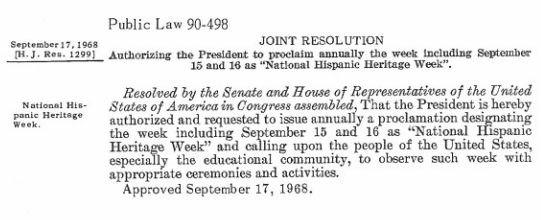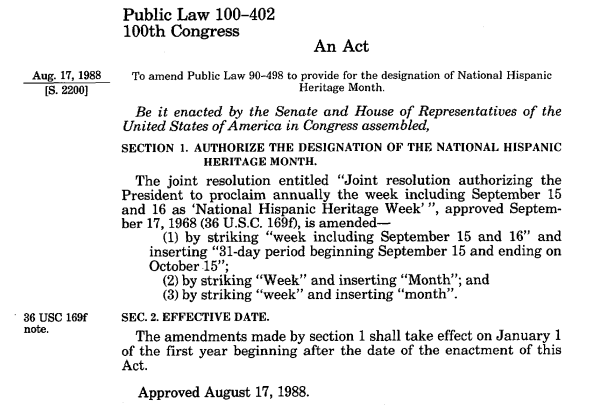Happy Hispanic Heritage Month! The yearly celebration began this week on September 15th, and will carry on until the 15th of next month. You might be familiar with the yearly festivals, events and activities, but the celebration of the contributions and accomplishments of Hispanic Americans in the United States dates back over 50 years. IQLatino brings you this brief history of what Hispanic Heritage Month means, and how and why it came about.
The idea of celebrating the contributions of Hispanic and Latino Americans in the United States gained momentum during the 1960s, as the Civil Rights Movement pushed a growing awareness of the country’s multicultural identities and their value. One such identity was that of American citizens with Spanish, Mexican, Caribbean and Central and South American ancestry.
In June of 1968, California Congressman George E. Brown first introduced a bill to establish what would originally be a week to celebrate Hispanic Heritage. Brown represented East Los Angeles and a portion of the San Gabriel Valley, areas heavily populated by Hispanic and Latino constituents. He wanted to recognize the role, influence and contributions of these communities in the history of the United States.
On September of the same year, Congress passed Public Law 90-48, which officially authorized a National Hispanic Heritage Week and requested the President to issue annual proclamations for the celebrations. Congress called on the “people of the United States, especially the educational community, to observe such week with appropriate ceremonies and activities.”

The same day, President Lyndon B. Johnson issued the first Hispanic Heritage Week presidential proclamation, which read:
It is with special pride that I call the attention of my fellow citizens to the great contribution to our national heritage made by our people of Hispanic descent—not only in the fields of culture, business, and science, but also through their valor in battle.
Several of our States and many of our cities proudly bear Hispanic names and continue Hispanic traditions that enrich our national life. The Commonwealth of Puerto Rico has given an example to the world by lifting the per capita income of its inhabitants through “Operation Bootstrap” from $256 to $1,047 in 10 years.
The people of Hispanic descent are the heirs of missionaries, captains, soldiers, and farmers who were motivated by a young spirit of adventure, and a desire to settle freely in a free land. This heritage is ours.
Johnson proceeded to declare the week of September 15 of 1968 the first National Hispanic Heritage Week. The date of September 15 as the kickoff of Hispanic Heritage Month is significant because it coincides with the independence day celebrations of what Johnson called the five “Central American Neighbors”: Costa Rica, El Salvador, Guatemala, Honduras, and Nicaragua, who declared their independence from Spain on September 15 of 1821. The following day marks Mexico’s declaration of independence from Spain on September 16 of 1810, and Chile and Belize also celebrate their independences during this week (Chile from Spain on September 18 of 1810 and Belize from Great Britain on September 21 of 1981).
For the next 20 years, Presidents Nixon, Ford, Carter and Reagan all issued yearly proclamations for a week to honor and celebrate Hispanic Americans. In 1987, Representative Esteban E. Torres of California proposed the expansion of the celebration to what it is today, 31 days of Hispanic Heritage Month. He wished to expand the celebration from a week to a month so that the country could “properly observe and coordinate events and activities to celebrate Hispanic culture and achievement.”
Senator Paul Simon from Illinois introduced a bill for the expansion in 1988, which passed Congress and was signed into law by President Ronald Reagan on August of that year. On September of 1989, President George H.W. Bush, who sponsored the original Hispanic Heritage Week resolution as a congressman in 1968, declared the first National Hispanic Heritage Month.

Every sitting president has made yearly National Hispanic Heritage Month proclamations since. The Library of Congress, National Archives and Records Administration, National Endowment for the Humanities, National Gallery of Art, National Park Service, Smithsonian Institution and United States Holocaust Memorial Museum are all sponsors of the celebration.
Today, over 60.6 million Hispanics live in the United States, making it the nation’s largest ethnic or racial minority, which constitutes over 18.5% of the population. This month, we take the time to celebrate and honor the heritage, arts, culture, customs, and contributions of all Latinos and Hispanics, past and present, who continue to enrich and strengthen the country that welcomed us and our ancestors in.
